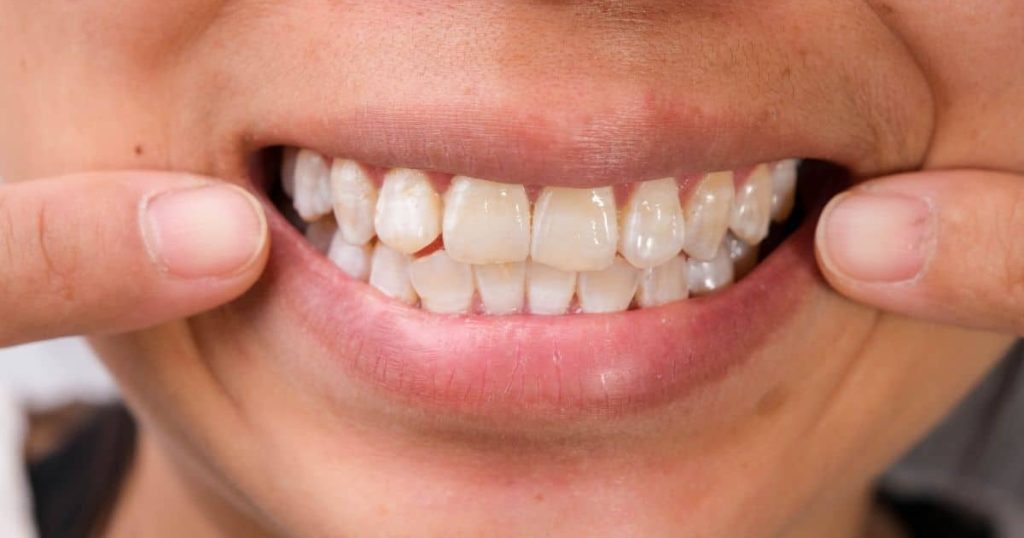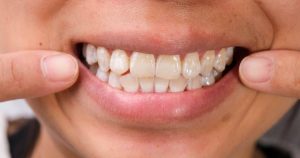White spots on teeth are surprisingly common and often overlooked, yet they can signal early changes in enamel health. These changes not only affect the appearance of your smile but can also indicate areas of weakened enamel that benefit from targeted care, including professional teeth whitening and other enamel-strengthening treatments.
In this blog, we’ll break down what causes white spots, explore both professional and home-based ways to manage them, and share practical tips for preventing new spots from forming. By the end, you’ll have a complete understanding of how to maintain a strong, healthy, and visually balanced smile.
What Are White Spots on Teeth and Are They Harmful?
White spots on teeth are small, pale patches that appear when the enamel loses its natural minerals or forms unevenly. In many cases, they’re an early sign of common dental problems like enamel demineralization or mild fluorosis, conditions that can make the tooth surface look chalky or dull. These spots form when minerals such as calcium and phosphate break down, often due to poor oral hygiene, excessive fluoride exposure, or issues that develop during tooth formation.
The good news is, white spots are usually not dangerous, but they can be early indicators of enamel weakening or decay. Many can be treated or even reversed with the right care and professional treatments. Because each case is different, the safest way to understand what’s behind those marks is through a professional oral examination, a simple checkup that helps identify whether the cause is harmless or needs attention.
Top Treatments to Fix White Spots on Teeth
The right treatment for white spots on teeth depends on what’s causing them and how deep the discoloration goes. Some cases need professional care at a dental clinic, while others can be improved with supportive at-home care to maintain results. In the next sections, we’ll look at both professional treatments and home remedies so you can find the best approach for your smile.
Professional and Specialized Treatments
When white spots appear on your teeth, a professional dental approach is often the most reliable way to bring back a smooth, even color. Depending on the cause and depth of the discoloration, your dentist may recommend one or a combination of the following treatments.
Enamel Microabrasion
This minimally invasive procedure gently removes a very thin layer of enamel using a mild abrasive or acid compound. It helps blend white spots with the surrounding enamel, especially in cases of fluorosis or superficial defects. Results are usually instant, and your dentist may follow up with whitening for an even tone.

ICON Resin Infiltration
ICON is a modern, non-invasive treatment that targets the porous enamel where white spot lesions form. A special resin is applied and light-cured, penetrating the enamel and matching its natural color and translucency. It’s highly effective for spots caused by orthodontic treatment or fluorosis, and it requires no drilling or anesthesia.
Professional Teeth Whitening
In-office whitening uses stronger bleaching agents than over-the-counter products, helping to lighten the overall enamel and reduce contrast between white spots and the rest of the tooth. While it’s effective for mild cases, dentists often pair it with treatments like ICON for a perfectly uniform result. To learn more about the procedure, its benefits, and expected costs, check out our guide on professional teeth whitening costs.
Dental Bonding
For moderate discoloration or enamel irregularities, your dentist can apply a tooth-colored composite resin over the affected area. This bonding treatment helps restore a consistent shade and smooth surface, blending seamlessly with your natural teeth. The procedure is quick, affordable, and usually completed in a single visit, making it a convenient option for getting rid of white spots on teeth and improving your smile without extensive dental work.
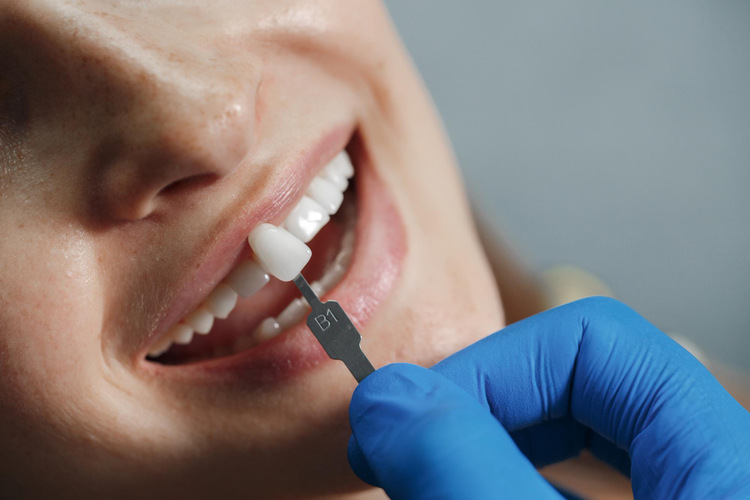
Porcelain Veneers
When white spots are extensive or resistant to other methods, porcelain veneers offer a long-lasting aesthetic fix. These custom-made thin shells are bonded to the front of your teeth to mask discoloration and improve shape. Veneers provide a complete smile makeover, though the process does involve slight enamel reduction, and you can learn more about this option through our veneers services.
If you’re considering veneers, you can compare them with Lumineers to see which suits your smile best: Veneers vs. Lumineers – Which Is Right for Your Smile?
Remineralization and Topical Fluoride Therapy
For early or mild cases, particularly related to enamel hypoplasia, dentists may use fluoride gels, calcium-phosphate pastes, or casein phosphopeptide (CPP-ACP) applications to help rebuild enamel minerals and prevent future decay.
Here’s a quick overview comparing the most common professional treatments for white spots on teeth:
| Treatment | Best for | Invasiveness | Duration/Result |
| ICON Resin Infiltration | Post-braces, fluorosis | Non-invasive | 1 visit, long-lasting |
| Microabrasion | Fluorosis, mild surface lesions | Minimally invasive | 1 visit, immediate results |
| Teeth Whitening | Mild spots | Non-invasive | Short-term improvement |
| Dental Bonding | Moderate enamel defects | Minimally invasive | 1 visit, lasts 3–5 years |
| Porcelain Veneers | Severe or widespread lesions | Moderately invasive | Lasts 10–15 years |
| Fluoride/Remineralization | Early enamel hypoplasia | Non-invasive | Gradual improvement |
Home Remedies for White Spots
Although professional treatments are the most effective for treating white spots on teeth, certain home practices can help support enamel health and enhance overall results. These approaches mainly work as complementary measures rather than standalone solutions.
As we mentioned earlier, using products that strengthen enamel like fluoride toothpaste, calcium-phosphate pastes, or casein phosphopeptides (CPP-ACP) can help protect teeth from further damage, and you can also explore ways to naturally strengthen weak teeth.
Maintaining excellent oral hygiene is another key factor: regular brushing, flossing, and using an antiseptic mouthwash help prevent plaque buildup, and you can also learn how to safely remove tartar at home to support your enamel. Limiting acidic foods and beverages, reducing sugar intake, and avoiding habits like excessive teeth grinding can further protect your teeth.
Finally, gentle whitening toothpastes or polishing powders can slightly improve the appearance of superficial spots.
For more at-home tips, you can check DIY teeth whitening methods.
Protect Your Smile from White Spots!
Don’t let white spots affect your confidence. Learn how professional care and at-home tips can keep your enamel healthy and even-toned. Explore effective treatments and preventive strategies for a brighter, spot-free smile.
Book Your Appointment Today to Start Your Path to Even, Radiant Teeth.
Patient Story: From White Spots to a Confident Smile
When Emily R., a 27-year-old teacher from Toronto, first visited Pape Dental Centre, she was frustrated with white patches on her front teeth. She had tried over-the-counter whitening products at home, but the spots remained noticeable.
During a comprehensive oral examination, our dental team assessed her enamel and identified mild post-orthodontic demineralization. We recommended a combination of dental bonding and professional teeth whitening, both offered at our clinic, to restore a smooth, even color.
In just a couple of appointments, the bonding masked the affected areas, and professional whitening brightened the overall enamel. At her follow-up, Emily shared, “I can finally smile without hesitation; it looks natural and even.”
Her story highlights how the right combination of professional treatments at Pape Dental can transform your smile safely and effectively.
What Causes White Spots on Teeth?
Understanding why white spots appear on teeth is the first step to addressing them effectively. Identifying the underlying cause helps your dentist choose the right treatment and prevent future enamel issues. White spots sometimes aren’t just a cosmetic concern; they often indicate areas where the enamel is weaker or mineralization is disrupted.
Fluorosis: Too Much Fluoride on Enamel
Fluorosis occurs when teeth are exposed to excessive fluoride during their development, usually in early childhood. This overexposure can cause white spots or streaks on the enamel, making it one of the common reasons for visible white marks on teeth. While mild fluorosis mainly affects appearance, it’s important to monitor fluoride intake carefully.
Read more: Fluoride treatment benefits and side effects
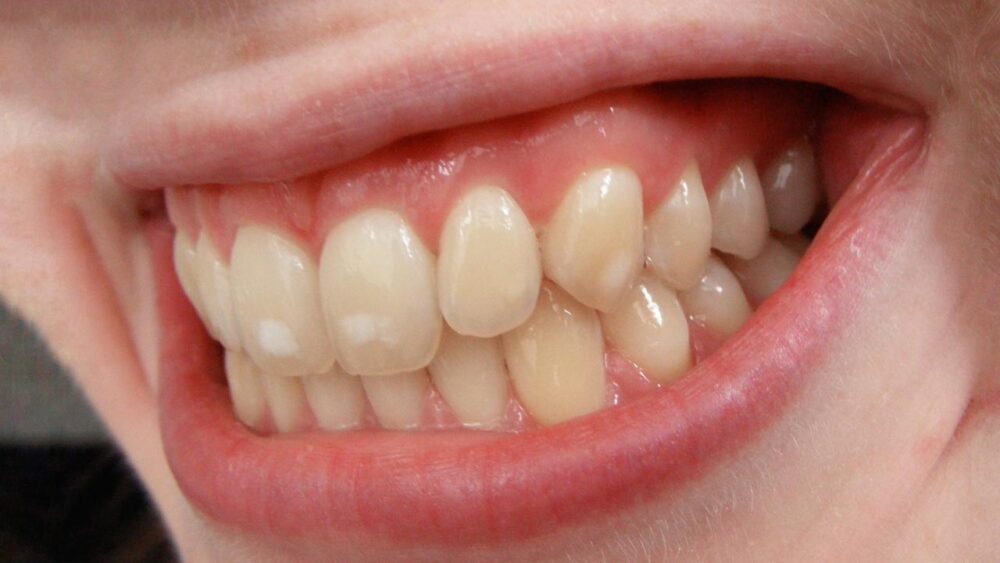
Demineralization and Plaque: The Hidden Culprits
White spots on teeth often appear as a result of demineralization, a process where minerals like calcium and phosphate are lost from the enamel. This usually happens in areas where plaque accumulates, creating an acidic environment that gradually weakens the tooth surface. Over time, these weakened areas show up as visible white marks, signaling the early stages of enamel damage. Maintaining regular dental cleaning can help remove plaque before it causes lasting demineralization.
If demineralization continues unchecked, it can progress to cavities and tooth decay. White spots can therefore be an early warning sign that more serious issues may develop. For more information on how enamel damage progresses and ways to protect your teeth, see our guide on tooth decay.
Staining from Foods, Drinks, or Habits
White spots on teeth can often be worsened or sometimes caused by what you eat, drink, or your daily habits. Enamel may become unevenly affected by acids and pigments, resulting in visible patches. Being mindful of these factors is key to maintaining a healthy, even smile.
Common contributors include:
- Acidic foods and drinks: Citrus fruits, sodas, and sports drinks can gradually erode enamel.
- Sugary foods: Candies, desserts, and sweetened beverages feed bacteria in plaque, producing acids that weaken enamel.
- Pigmented foods and drinks: Coffee, tea, wine, berries, tomato sauce, and cola can leave stains and contribute to enamel wear. This is why many people seek teeth whitening for coffee and tea drinkers to restore brightness.
- Lifestyle habits: Smoking, excessive fluoride intake during childhood, or improper use of whitening products can create uneven enamel patches. Avoiding smoking after teeth whitening is also crucial to maintaining results.
Check out: Foods to Avoid After Teeth Whitening
Enamel Hypoplasia: When Teeth Don’t Form Right
Enamel hypoplasia is a developmental defect that occurs when the enamel, the hard outer layer of your teeth, doesn’t form properly. This condition can affect one or several teeth, leading to thin, weak, or uneven enamel surfaces that make teeth more prone to sensitivity and decay. Because enamel cannot regenerate, early detection and professional management are crucial.
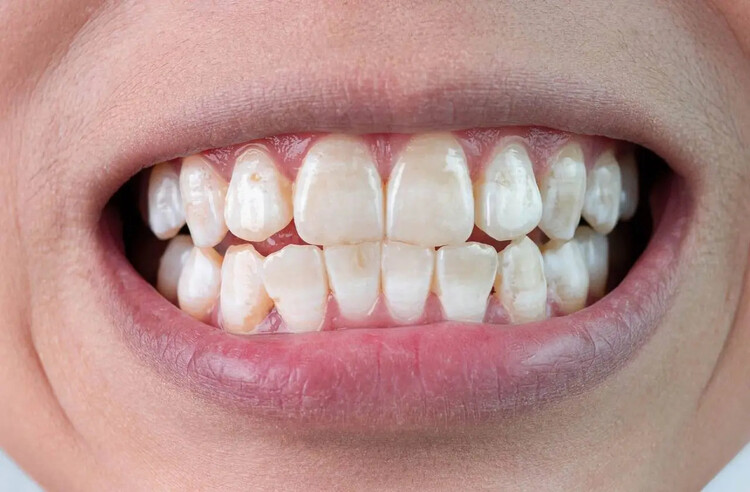
For patients with enamel hypoplasia causing white spots on teeth, modern restorative dentistry offers effective solutions to protect and rebuild the affected teeth. Depending on the severity, treatments may include fluoride applications, dental sealants, or customized restorations that strengthen the enamel and restore both the health and natural look of your smile.
Note: Since this condition often starts during the formative years, regular dental exams for children play a vital role in spotting enamel defects early.
How to Prevent White Spots with Better Oral Hygiene
Keeping white spots away starts with simple but consistent oral hygiene habits. When your daily care routine supports strong enamel, your teeth stay bright, balanced, and free of uneven discoloration. Here are a few essential tips to help prevent white spots on teeth from developing:
- Brush twice a day with a fluoride toothpaste to strengthen enamel and remove early plaque buildup.
- Floss daily to clean areas your toothbrush can’t reach and reduce demineralization between teeth.
- Limit sugary snacks and acidic drinks that weaken enamel and promote bacterial growth.
- Drink plenty of water to wash away food particles and maintain a neutral mouth pH.
- Schedule routine dental checkups and professional cleanings to detect early signs of enamel changes.

By following these habits and getting regular care through our preventive dentistry, you can keep your smile healthy, protected, and naturally radiant for years to come.
Suggested article: Oral Hygiene Mistakes
Your Path to a Spot-Free Smile
White spots on teeth can have many causes, from excess fluoride and plaque buildup to enamel defects or staining. The good news? Most cases are manageable with the right mix of professional treatments and at-home care. Understanding the cause is the first step toward restoring your confident smile.
At Pape Dental Centre, we specialize in helping patients achieve naturally bright, even-toned smiles through personalized care plans. Whether you’re dealing with white spots, discoloration, or other cosmetic concerns, our team combines advanced techniques with a gentle approach to help you love your smile again.
FAQ
How do I get rid of white spots on my teeth fast?
Professional treatments like ICON resin infiltration, microabrasion, or dental bonding are the quickest and most effective ways to reduce white spots. Home remedies mainly support enamel health and don’t remove spots completely.
Do white spots on teeth go away?
White spots don’t usually disappear on their own. Mild spots may improve with remineralization or whitening, but persistent marks often require professional care.
Are white spots on teeth harmful?
Most white spots are cosmetic, but they can indicate weaker enamel or early demineralization, which could lead to cavities if untreated.
Can you get rid of calcium spots on teeth?
Calcium deposits, like other white spots, can be minimized with professional treatments such as microabrasion, bonding, or veneers, depending on severity.
Have you ever noticed small white patches on your teeth or tried any home remedies for them? Share your experience or questions in the comments; we look forward to hearing about your experience!
